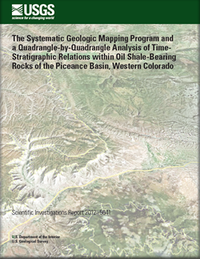During the 1960s, 1970s, and 1980s, the U.S. Geological Survey mapped the entire area underlain by oil shale of the Eocene Green River Formation in the Piceance Basin of western Colorado. The Piceance Basin contains the largest known oil shale deposit in the world, with an estimated 1.53 trillion barrels of oil in place and as much as 400,000 barrels of oil per acre. This report places the sixty-nine 7½-minute geologic quadrangle maps and one 15-minute quadrangle map published during this period into a comprehensive time-stratigraphic framework based on the alternating rich and lean oil shale zones. The quadrangles are placed in their respective regional positions on one large stratigraphic chart so that tracking the various stratigraphic unit names that have been applied can be followed between adjacent quadrangles. Members of the Green River Formation were defined prior to the detailed mapping, and many inconsistencies and correlation problems had to be addressed as mapping progressed. As a result, some of the geologic units that were defined prior to mapping were modified or discarded. The extensive body of geologic data provided by the detailed quadrangle maps contributes to a better understanding of the distribution and characteristics of the oil shale-bearing rocks across the Piceance Basin.


